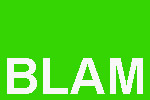BLAM
BLAM was founded about 50 years ago to facilitate contact
Bryophyte and Lichen of the Year 2023
Urban heat island & climate change adaptation: mosses and lichens in green roofs: Tortella inclinata and Cladonia rangiformis are bryophyte and lichen of the year 2023 (text in German).
![Cladonia rangiformis, Windsheimer Bucht, Franken [W. v. Brackel] Cladonia rangiformis, Windsheimer Bucht, Franken [W. v. Brackel]](/images/BilderMFdJ2023/Cladonia_rangiformis_Kuelsheimer_GH_2018_10_2_WvB_small.jpg) After the temporal development of scientific findings was used as the selection criterion for Moss and Lichen of the Year last year, it is once again an ecological topic in 2023. This time, the focus is on the use of mosses and lichens in green roofs, which can be used to mitigate the overheating of cities in summer - keyword "urban heat island" - as well as the load on sewage systems during short heavy rain events. The one by cooling through water evaporation and the plant turf also acting as an additional thermal insulation, the other by absorbing and retaining rainwater and at best delaying runoff. These benefits of green roofs (but also green facades) are important for making our cities more resilient to the consequences of climate change. With Tortella inclinata and Cladonia rangiformis (photo), two species were selected that occur naturally in strongly drying biotopes such as semi-arid grasslands and also spontaneously colonize green roofs.
After the temporal development of scientific findings was used as the selection criterion for Moss and Lichen of the Year last year, it is once again an ecological topic in 2023. This time, the focus is on the use of mosses and lichens in green roofs, which can be used to mitigate the overheating of cities in summer - keyword "urban heat island" - as well as the load on sewage systems during short heavy rain events. The one by cooling through water evaporation and the plant turf also acting as an additional thermal insulation, the other by absorbing and retaining rainwater and at best delaying runoff. These benefits of green roofs (but also green facades) are important for making our cities more resilient to the consequences of climate change. With Tortella inclinata and Cladonia rangiformis (photo), two species were selected that occur naturally in strongly drying biotopes such as semi-arid grasslands and also spontaneously colonize green roofs.
Look here for recent species of the year:
2008: Orthotrichum pulchellum und Letharia vulpina
2009: Leucobryum glaucum und Cladonia rangiferina
2010: Polytrichum commune und Dibaeis baeomyces
2011: Thuidium abietinum und Fulgensia fulgens
2012: Buxbaumia viridis und Lobaria pulmonaria
2013: Marchantia polymorpha und Peltigera didactyla
2014: Hedwigia ciliata und Rhizocarpon geographicum
2015: Schistostega pennata und Psilolechia lucida
2016: Sphagnum magellanicum und Icmadophila ericetorum
2017: Ctenidium molluscum und Variospora flavescens
2018: Bartramia pomiformis und Umbilicaria cylindrica
2019: Cryphaea heteromalla
2020: Ptilidium pulcherrimum und Cladonia digitata
2021: Rhytidiadelphus squarrosus and Lecanora muralis and Lecanora muralis
2022: Enchylium tenax and Diobelonella palustris
Becoming a member
Membership is open to anyone, professional and amateur. Members receive the society's journal HERZOGIA and have the possibilty to join excursions (mainly to the Alps, Tatra, etc).
If you wish to join please contact the to the treasurer Dr. Martin Nebel, Wellingstraße 14, 70619 Stuttgart, Germany.
Annual subscription is 30 € (students and seniors 20 €).
Our society bulletin is been named Herzogiella
The first volume was published recently and mailed to all members. Editorial board: Stefan Kaufmann & Dietmar Teuber. Please mail manuscripts (excursion reports, species lists, comments on books, small papers dealing with lichens and/or bryophytes, notes on events etc.) to Dietmar Teuber before January 2023.
Purchasing publications
HERZOGIA (current or back issues) can be purchased by sending an E-mail to the treasurer Dr. Martin Nebel, Wellingstraße 14, 70619 Stuttgart
Our bank account details
Name beneficient: BryolLichenolArbeitsgem
Place beneficient: Bad Duerkheim Country beneficient: Germany
SWIFT/BIC: MALADE51DKH IBAN: DE49 5465 1240 0000 5793 00
Name of the bank: Sparkasse Rhein-Haardt
BLAM-Mailinglist blam-web
This is a mailinglist open for people interested in bryology and lichenology. Language is mainly German or English. For subscription, go to "blam-web"-Website (at University of Graz, Austria; English version available) and fill the form. You will be sent an email requesting confirmation. Once confirmation is received, your request will be held for approval by the list moderator. You will be notified of the moderator's decision by email. The list of members is not available to non-members.










